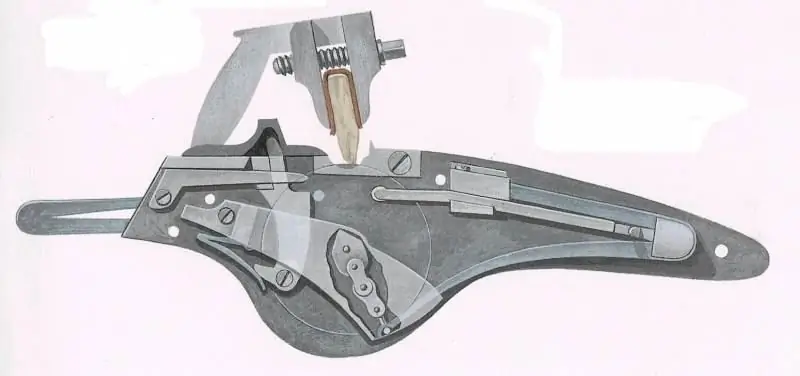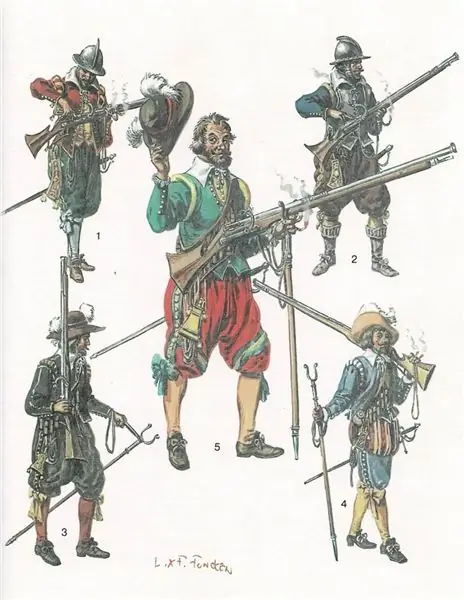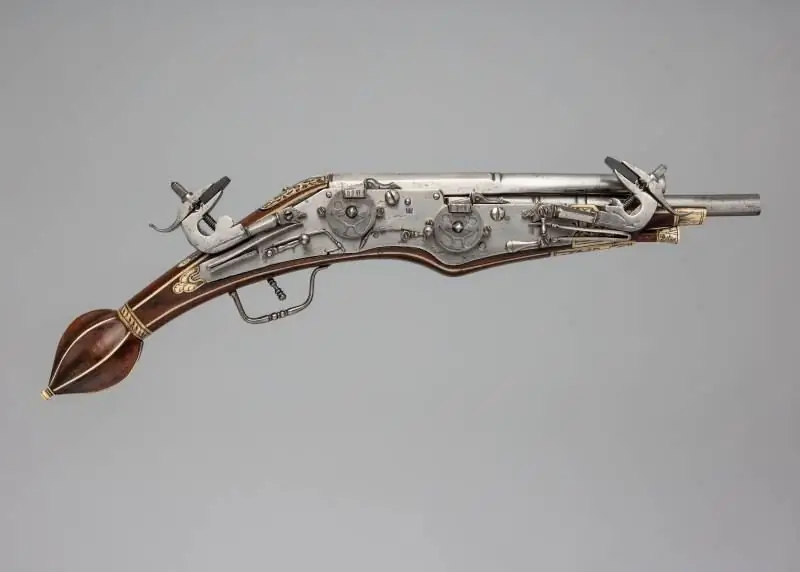- Author Matthew Elmers [email protected].
- Public 2024-01-11 04:35.
- Last modified 2025-01-24 09:17.

We got into a fight on Silver Street …
We would fight now
But the revolver, unfortunately, was grabbed by one of us.
"Badges" Rudyard Kipling
The history of firearms. Last time we stopped at the fact that the wick lock became the main mechanism for igniting the powder charge in the barrel, and this mechanism existed in Japan and also in Tibet for a very long time. Until 1868! Well, hunters - they could even use matches! Remember N. A. Nekrasov:
Kuzya broke the trigger at the gun, Matchesk carries a box with him, Sits behind a bush - lure a grouse, He will attach a match to the seed - and it will break out!
However, human thought did not stand still, and very soon a wheel lock was invented to ignite the powder charge. Where and by whom? Impossible to say. A diagram of the device of such a lock was discovered in the book by Leonardo da Vinci "Codex Atlanticus" 1505. And this is essentially his only invention, which became widespread during his lifetime. But there is also a manuscript by Martin Löfelholz, dating from the same year, which also depicts a very similar incendiary device. So which of them was the very first, it's hard to say. Again, there is nothing surprising in the fact that we do not know for sure the author of this invention.
An ordinary lighter - that's what it is
The fact is that since matches did not exist at that time, people constantly had to deal with a variety of devices for making fire. Here you have a chair, a tinder (a piece of linen cloth burnt on a fire), and, most likely, the banal wheel lighter that appeared already then (only without a can of gas, of course), in which a toothed wheel was twisted with a finger, and pyrite pressed against it, or the flint gave a sheaf of sparks that fell on the tinder and ignited it. And it didn't take a lot of mind to come up with the idea of putting the same thing on a musket or arquebus and connecting it to the trigger. True, it was necessary to do something - not with a finger, of course - to turn the wheel itself. But this was already a purely technical solution: a wheel with teeth was connected to a spring through a short chain and a stopper was attached to it - and so the wheel lock was born!

First of all, the new lock surpassed wick locks in reliability. He was not so sensitive to moisture and could be cocked for a long time. If it used hard flint, then the notch on the wheel quickly wore out. Soft pyrite did not spoil it like that, but it itself crumbled, and its particles contaminated the lock mechanism. In addition, it had a lot of details (at least 25!), And therefore it was very expensive. So, in 1580, an arquebus with a wick lock could be bought for 350 francs, but the same arquebus, but with a wheel lock, cost at least 1500 francs. In addition, a key was required to wind up its mechanism - if the shooter lost it, then his weapon also became useless. But the fact that such a weapon could be carried covertly and just as suddenly and unexpectedly caused a completely predictable reaction of rejection (so great was the fear of this novelty!), So in 1506 wheel locks were banned in Geislingen, and in Hamburg and In a number of other German cities, carrying pistols with such a lock without the permission of the magistrate was punishable by cutting off the hand.

By the way, it was thanks to the wheel lock that the pistols appeared. The wick-lock pistol was very inconvenient, although it was used in Japan. But the new castle immediately raised military affairs in Europe to a completely new level. Now it was possible to arm the cavalry with such a weapon, and … riders-pistoliers - reitars and cuirassiers - immediately entered the battlefields, replacing the former knightly cavalry.

Accordingly, this led to the last most serious thickening and weighting of the rider's armor, which now counted on protection from a bullet fired from a wheeled pistol almost point-blank! However, there was a whole series of articles about what the cavalry of the New Time was like, so we will not develop this topic here, but we will continue to get acquainted with the changes that the wheel castle made to military affairs.
Without a key - nowhere
But the Japanese samurai riders used match pistols and did not complain. One can only imagine how much attention the jump demanded from them with a lit fuse in their hands or already in the weapon, so that it would not burn out from the headwind, so that it would not fall out of the serpentine, and the horse, too, could not be ignored. And then you still had to shoot at the enemy and then jump back. He simply could not have a second pistol ready to fire, while a European rider could have quite a lot of wheeled pistols!

And, by the way, again, we note that these changes mainly affected the cavalry, but the infantry continued to use the wick lock. It was simple and cheap, and then the military took the quantity, leaving the quality to the cavalry!

The wheel lock began to be widely used in hunting weapons - since at that time only the nobility hunted with firearms, and she could afford the most modern weapons at that time, as well as in weapons for target shooting - here God himself ordered the use of this lock, because it really made it possible to turn gun shooting into real entertainment.
Weapons for hunting and shooting fun

The Dukes of Bavaria were keen collectors who collected exotic objects and works of art in a special gallery called the Kunstkamera. In the capital of Munich, they opened various workshops, where the most skilled artists and craftsmen produced objects of art for the princely collection or for gifts to foreign dignitaries. Among the artists employed by the Munich court were steel carvers Emanuel Sadeler (active 1594-1610), his brother Daniel (recorded 1602-1632) and Kaspar Speth (circa 1611-1691). Unlike other artists, they did not try to achieve a decorative effect using a large amount of gold, but used it mainly as a background to emphasize the blued steel ornament, carved in high relief. They usually took plots and patterns of decor from drawings of Flemish and French artists of the second half of the 16th century, made in the style of Mannerism. Craftsmen of wood, ivory and horn carving and engraving such as Jerome Borstorfer (1597-1637) and Elias Becker (1633-1674) have been called upon to create ornate armory boxes of the highest quality to match the magnificent barrels and weapons. The locks were made by Sadeler and Spaat.
But the most interesting thing is that, although the first "multi-barreled" weapons appeared in the era of absolute domination of the matchlock, it was the wheel lock that made it possible to create effective multi-barreled - usually double-barreled types of such weapons. However, the match weapon was also improved. True, mostly hunting - here the masters could not limit themselves to anything. They did not limit, so even the wicked muskets-revolvers they created have come down to us!

But double-barreled pistols with wheel locks began to be used by both cuirassiers and reitars. And no wonder! After all, the pistols of that time were large and heavy. Two pistols were placed in saddle holsters, since their length was half a meter, two more could be tucked into the tops of boots, and two more were somehow tucked into a belt or placed on a special harness. That is, six barrels to the maximum, and each weighing at least one and a half kilograms, or even more. And also a cuirass, legguards, a helmet, a sword, a powder flask, natruska, a bag with bullets … But all these problems were solved by the presence of only a double-barreled pistol: two of these pistols were already four shots, and four - eight, while their total weight increased insignificantly.
Two barrels are better than one

It is interesting that the "ball" ("apple") at the end of the pistol grip did not serve at all to hit the opponent on the head in hand-to-hand combat, although this also happened. Usually it was hollow, unscrewed and served as a container for spare flints or pyrites.

The "secret door" (a small case on the right side with a sliding lid) was a fashionable fixture on the butts of wheeled muskets. It was customary to store bullets there, ready for use, that is, wrapped in an oiled cloth or just a piece of paper.


But it turned out so strange that the era, one might say, of the flourishing of weapons with wheel locks simultaneously became the era of the emergence of exceptionally perfect samples of much older weapons, for which this time became at the same time the end of its existence. But we will talk about what kind of weapon it was next time …






